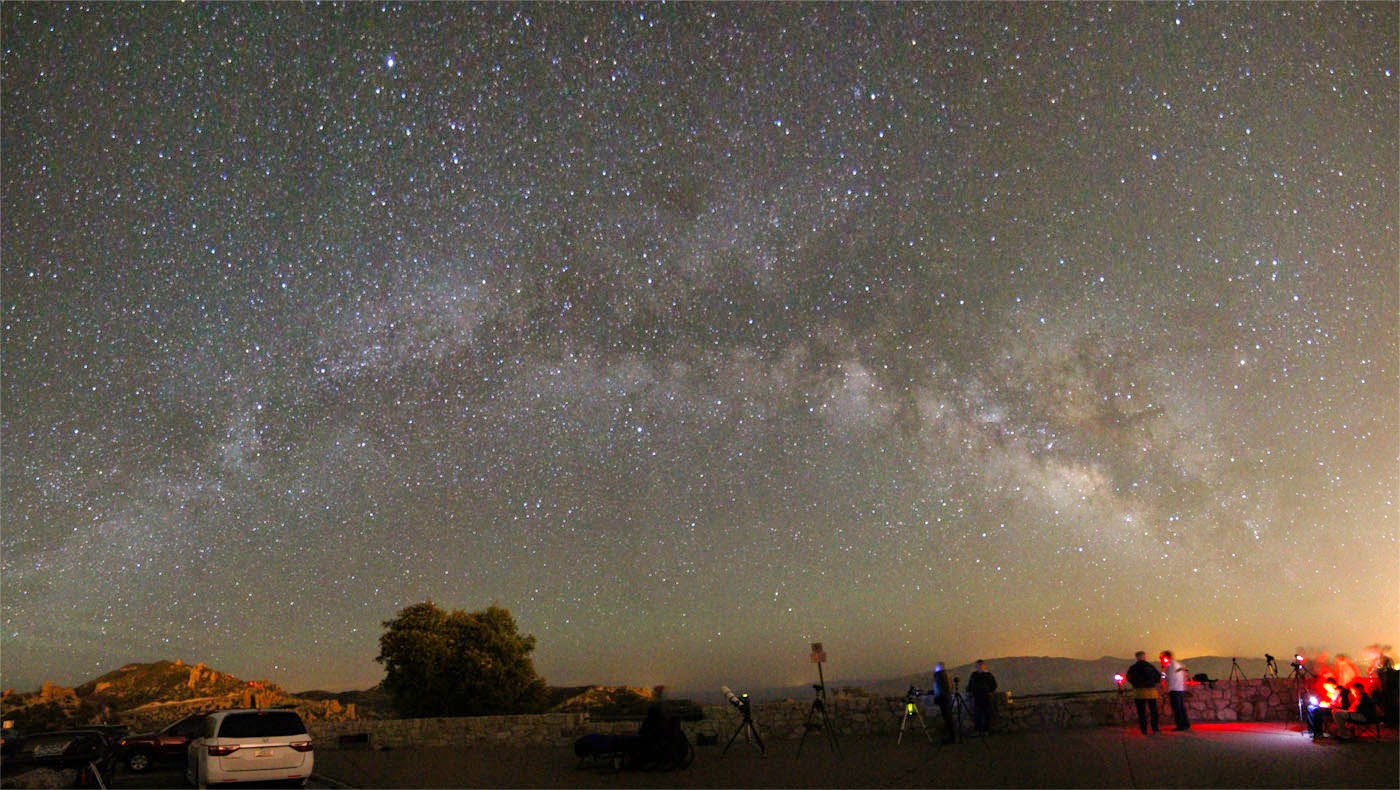Two nights ago there was a chance of a storm - a "meteor storm"! The source was a small comet discovered about 10 years ago, 209P/Linear. Most meteors are from near-microscopic dust released from comets as their ices warm when they near the sun. It so happens that on Friday night the earth was to pass by a possible swarm of particles released nearly 200 years ago by the comet. While predictions of comet appearance are notoriously unpredictable, some experts were predicting storm-levels of meteors, upwards of 400/hour! This shower was to appear to come from the unimpressive constellation of Camelopardalis (the Giraffe), so the meteors would be called Camelopardalids...
Melinda and I decided to drive in search of dark northern skies, which for us in Midtown Tucson, meant a trip up to Geology Vista on the Mount Lemmon Highway. We often go there for the Perseid Meteor Shower in August as it takes less than an hour for us to get to the site, about 6500 feet elevation. After a long day of work, and chores at home, we didn't leave until after 10pm, arriving a little late for the 11pm to 1am predicted peak. We arrived to a zoo! Geology Vista, normally a lonely place at night was packed as we glided into the last parking spot. There seemed a large number of people taking photos, there were a few scopes set up and some just watching from lawn chairs. I got Melinda set up in a comfy chair, and I set up a tripod, and decided to play some with the new T3 Canon obtained from sister-in-law Susan's estate - its first time in a dark sky. It didn't take long to see there wasn't a storm of meteors taking place, but shortly after arriving we saw a brilliant meteor slowly moving north parallel to the eastern horizon - NOT a Camelopardalid. and of course, NOT in my camera field of view...
The new-generation camera, only 18 months old, is a significant upgrade from my 6-year-old XSi. While the T3 is not a top level camera, the significant difference for astronomy is that the ISO goes a factor of 4 higher to 6400 and likely has better noise characteristics, so decided to see how it performed at that speed. The rising Milky Way was an impressive view in the East, so installed the Samyang 14mm lens, and set it to F/4 for these exposures. At ISO 6400, I exposed for 30 seconds (!) for the shot at left.
Even with the ultra-wide 14mm lens, only parts of the Milky Way could be imaged, so I did what has been popular these days - panorama time! Turning the camera to a vertical composition, and moving between frames, Photoshop can assemble them into a ultra-wide shot taking in the entire sweep of the galaxy! Of course, by this time, the parking lot got even fuller, with cars now double and triple-parked, and the Midnight traffic for the holiday weekend seemed more suited for midtown Speedway than the Mount Lemmon Highway! For those shots taking in the sweep of the landscape, it was tough to miss the cars passing along in 30 second exposures... The 6-frame panorama shown here reaches from the broadcast towers, Polaris and the Little Dipper at left around to rising Scorpius in the SSE. This was assembled from 20 second exposures, and Photoshop never burped in assembling them into the panoramas shown here.
I couldn't decide between the ultra-wide panorama shown above, or this one with a slightly shorter arc, so both are displayed here. By the time I was having fun with these, Melinda was climbing into the car to "rest her eyes", and without the meteors to observe, it was tough to justify staying up late with my need to go to work Saturday morning, so left about 1245. By this time there was a banjo and guitar playing tunes, about a dozen cameras working, and still a parking spot shortage, so we gave ours up... The verdict on the camera - shows promise! While ISO 6400 might be pushing it a bit, there are very few hot pixels in 30 second exposures. The 14mm lens isn't sharp enough to enlarge much more than these down-sampled images here, so will be trying other optics in the future. Unpacking the camera later, I was amazed how light the camera was - only 460 grams - right at 1 pound without the lens - amazingly light for all the features it offers! The verdict on the meteor shower - less promising, but Camelopardalids were seen, just not the storm levels some had predicted. I think it is still amazing they can predict a new shower like this at all, and if it gets people out looking upwards, all the better!
EDIT: I'm sorry if I made it seem like Photoshop is required for assembling the sky panoramas shown. I know it is expensive and not everyone can add it to your software package. As a University employee, I get the educational version (same as full-price, actually) for a much-reduced cost. This morning I've been playing around with the Microsoft ICE (Image Composite Editor), and it does a fine job lining these up too and it is free! You still need a program to adjust brightness and contrast, but you don't need the hundreds of dollars for Photoshop. So get out there, start shooting and have fun!
The Best Laid Plans...Updated
1 week ago




































































